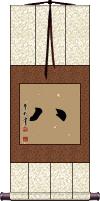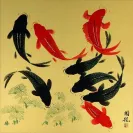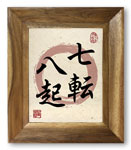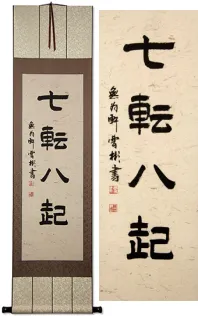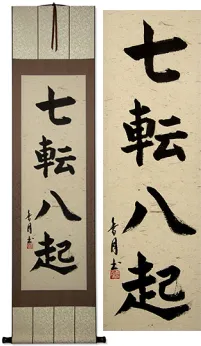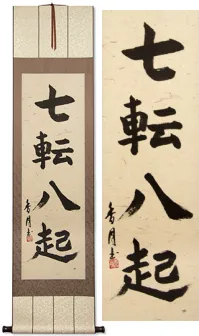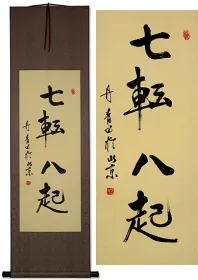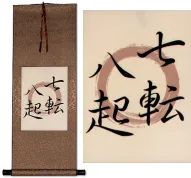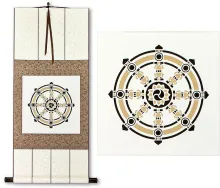Many custom options...
And formats...

The name Number Eight in Chinese / Japanese...
Buy a Number Eight calligraphy wall scroll here!
Eight
The number eight
八 is the number eight in Chinese, Japanese Kanji, and old Korean Hanja.
八 is a strange selection for a wall scroll, so it's here mostly for reference. I guess it's OK if the number eight is important to you.
Because this character is rather simple (just two strokes), 捌 instead of 八 is an anti-fraud way to write eight on bank documents.
This in-stock artwork might be what you are looking for, and ships right away...
Gallery Price: $180.00
Your Price: $99.88
Gallery Price: $222.00
Your Price: $122.88
Gallery Price: $222.00
Your Price: $122.88
Gallery Price: $100.00
Your Price: $49.88
Gallery Price: $100.00
Your Price: $39.88
Not the results for number eight that you were looking for?
Below are some entries from our dictionary that may match your number eight search...
| Characters If shown, 2nd row is Simp. Chinese |
Pronunciation Romanization |
Simple Dictionary Definition |
地獄 地狱 see styles |
dì yù di4 yu4 ti yü jigoku じごく |
More info & calligraphy: Hell(1) {Buddh} hell realm; Naraka; (2) {Christn} Hell; (3) hell; misery; nightmare; inferno; (4) place where a volcano or hot springs constantly spew smoke or steam; (place-name) Jigoku naraka, 捺落迦 (or 那落迦) ; niraya 泥犂; explained by 不樂 joyless; 可厭 disgusting, hateful; 苦具, 苦器 means of suffering; if 地獄 earth-prison; 冥府 the shades, or departments of darkness. Earth-prison is generally intp. as hell or the hells; it may also be termed purgatory; one of the six gati or ways of transmigration. The hells are divided into three classes: I. Central, or radical, 根本地獄 consisting of (1) The eight hot hells. These were the original hells of primitive Buddhism, and are supposed to be located umder the southern continent Jambudvīpa 瞻部州, 500 yojanas below the surface. (a) 等活 or 更活 Saṃjīva, rebirth, where after many kinds of suffering a cold wind blows over the soul and returns it to this life as it was before, hence the name 等活. (b) 黑繩 Kaslasūtra, where the sufferer is bound with black chains and chopped or sawn asunder. (c) 線合; 衆合; 堆壓 Saṃghāta, where are multitudes of implements of torture, or the falling of mountains upon the sufferer. (d) 號呌; 呼呼; 叫喚 Raurava, hell of wailing. (e) 大呌; 大號呌; 大呼 Mahāraurava, hell of great wailing. (f) 炎熱; 燒炙 Tapana, hell of fames and burning. (g) 大熱; 大燒炙; 大炎熱 Pratāpana, hell of molten lead. (h) 無間; 河鼻旨; 阿惟越致; 阿毗至; 阿鼻; 阿毗 Avīci, unintermitted suffering, where sinners die and are reborn to suffer without interval. (2) The eight cold hells 八寒地獄. (a) 頞浮陀地獄 Arbuda, where the cold causes blisters. (b) 尼刺部陀 Nirarbuda, colder still causing the blisters to burst. (c) 頞哳吒; 阿吒吒 Atata, where this is the only possible sound from frozen lips. (d) 臛臛婆; 阿波波 Hahava or Apapa, where it is so cold that only this sound can be uttered. (e) 虎虎婆 Hāhādhara or Huhuva, where only this sound can be uttered. (f) 嗢鉢羅; 鬱鉢羅 (or 優鉢羅) Utpala, or 尼羅鳥 (or 漚) 鉢羅 Nīlotpala, where the skin is frozen like blue lotus buds. (g) 鉢特摩 Padma, where the skin is frozen and bursts open like red lotus buds. (h) 摩訶鉢特摩 Mahāpadma, ditto like great red lotus buds. Somewhat different names are also given. Cf. 倶舍論 8; 智度論 16; 涅槃經 11. II. The secondary hells are called 近邊地獄 adjacent hells or 十六遊增 each of its four sides, opening from each such door are four adjacent hells, in all sixteen; thus with the original eight there are 136. A list of eighteen hells is given in the 十八泥梨經. III. A third class is called the 孤地獄 (獨地獄) Lokāntarika, or isolated hells in mountains, deserts, below the earth and above it. Eitel says in regard to the eight hot hells that they range 'one beneath the other in tiers which begin at a depth of 11,900 yojanas and reach to a depth of 40,000 yojanas'. The cold hells are under 'the two Tchahavālas and range shaft-like one below the other, but so that this shaft is gradually widening to the fourth hell and then narrowing itself again so that the first and last hell have the shortest, those in the centre the longest diameter'. 'Every universe has the same number of hells, ' but 'the northern continent has no hell whatever, the two continents east and west of Meru have only small Lokāntarika hells... whilst all the other hells are required for the inhabitants of the southern continent '. It may be noted that the purpose of these hells is definitely punitive, as well as purgatorial. Yama is the judge and ruler, assisted by eighteen officers and a host of demons, who order or administer the various degrees of torture. 'His sister performs the same duties with regard to female criminals, ' and it may be mentioned that the Chinese have added the 血盆池 Lake of the bloody bath, or 'placenta tank' for women who die in childbirth. Release from the hells is in the power of the monks by tantric means. |
戒 see styles |
jiè jie4 chieh kai; ingoto(ok) かい; いんごと(ok) |
to guard against; to exhort; to admonish or warn; to give up or stop doing something; Buddhist monastic discipline; ring (for a finger) (1) (かい only) {Buddh} admonition; commandment; (2) sila (precept) śīla, 尸羅. Precept, command, prohibition, discipline, rule; morality. It is applied to the five, eight, ten, 250, and other commandments. The five are: (1) not to kill; (2 ) not to steal; (3) not to commit adultery; (4) not to speak falsely; (5) not to drink wine. These are the commands for lay disciples; those who observe them will be reborn in the human realm. The Sarvāstivādins did not sanction the observance of a limited selection from them as did the 成實宗 Satyasiddhi school. Each of the five precepts has five guardian spirits, in all twenty-five, 五戒二十五神. The eight for lay disciples are the above five together with Nos. 7, 8, and 9 of the following; the ten commands for the ordained, monks and nuns, are the above five with the following: (6) not to use adornments of flowers, nor perfumes; (7) not to perform as an actor, juggler, acrobat, or go to watch and hear them; (8) not to sit on elevated, broad, and large divans (or beds); (9) not to eat except in regulation hours; (10) not to possess money, gold or silver, or precious things. The 具足戒full commands for a monk number 250, those for a nun are 348, commonly called 500. Śīla is also the first of the 五分法身, i.e. a condition above all moral error. The Sutra of Brahma's Net has the following after the first five: (6) not to speak of the sins of those in orders; (7) not to vaunt self and depreciate others; (8) not to be avaricious; (9) not to be angry; (10) not to slander the triratna. |
三八 see styles |
sān bā san1 ba1 san pa sanpachi さんぱち |
International Women's Day 婦女節|妇女节[Fu4 nu:3 jie2], 8th March; foolish; stupid (1) three and eight; (2) (abbreviation) (See 三八式歩兵銃) Arisaka Type 38 rifle; (personal name) Miya (days ending with the number) 3 and 8 |
八百 see styles |
yamomo やもも |
(1) eight hundred; (2) multitude; large number; (surname) Yamomo |
十二 see styles |
shí èr shi2 er4 shih erh tooji とおじ |
twelve; 12 12; twelve; (given name) Tooji dvātriṃśa. Thirty-two. 三十二應 (or 三十二身) The thirty-two forms of Guanyin, and of Puxian, ranging from that of a Buddha to that of a man, a maid, a rakṣas; similar to the thirty-three forms named in the Lotus Sūtra. 三十二相三十二大人相 dvātriṃśadvaralakṣaṇa. The thirty-two lakṣaṇas, or physical marks of a cakravartī, or 'wheel-king', especially of the Buddha, i. e. level feet, thousand-spoke wheel-sign on feet, long slender fingers, pliant hands and feet, toes and fingers finely webbed, full-sized heels, arched insteps, thighs like a royal stag, hands reaching below the knees well-retracted male organ, height and stretch of arms equal, every hair-root dark coloured, body hair graceful and curly, golden-hued body, a 10 ft. halo around him, soft smooth skin, the 七處, i. e. two soles, two palms, two shoulders, and crown well rounded, below the armpits well-filled, lion-shaped body, erect, full shoulders, forty teeth, teeth white even and close, the four canine teeth pure white, lion-jawed, saliva improving the taste of all food, tongue long and broad, voice deep and resonant, eyes deep blue, eyelashes like a royal bull, a white ūrnā or curl between the eyebrows emitting light, an uṣṇīṣa or fleshy protuberance on the crown. These are from the 三藏法數 48, with which the 智度論 4, 涅盤經 28, 中阿含經, 三十ニ相經 generally agree. The 無量義經 has a different list. 三十二相經 The eleventh chapter of the 阿含經. 三十二相經願 The twenty-first of Amitābha's vows, v. 無量壽經. 三十三 trayastriṃśat. Thirty-three. 三十三天忉利天; 憺梨天, 多羅夜登陵舍; 憺利夜登陵奢; 憺利耶憺利奢 Trayastriṃśas. The Indra heaven, the second of the six heavens of form. Its capital is situated on the summit of Mt. Sumeru, where Indra rules over his thirty-two devas, who reside on thirty-two peaks of Sumeru, eight in each of the four directons. Indra's capital is called 殊勝 Sudarśana, 喜見城 Joy-view city. Its people are a yojana in height, each one's clothing weighs 六鐵 (1; 4 oz. ), and they live 1, 000 years, a day and night being equal to 100 earthly years. Eitel says Indra's heaven 'tallies in all its details with the Svarga of Brahminic mythology' and suggests that 'the whole myth may have an astronomical meaning', or be connected, with 'the atmosphere with its phenomena, which strengthens Koeppen's hypothesis explaining the number thirty-three as referring to the eight Vasus, eleven Rudras, twelve Ādityas, and two Aśvins of Vedic mythology'. In his palace called Vaijayanta 'Indra is enthroned with 1, 000 eyes with four arms grasping the vajra. There he revels in numberless sensual pleasures together with his wife Śacī... and with 119, 000 concubines with whom he associates by means of transformation'.; dvādaśa, twelve. |
法相 see styles |
fǎ xiàng fa3 xiang4 fa hsiang hossou / hosso ほっそう |
(1) {Buddh} (See 法性) dharmalaksana (dharma characteristics, the specific characteristics of all manifest phenomena); (2) (abbreviation) (See 法相宗) Hosso sect of Buddhism The aspects of characteristics of things-all things are of monad nature but differ in form. A name of the 法相宗 Faxiang or Dharmalakṣaṇa sect (Jap. Hossō), called also 慈恩宗 Cien sect from the Tang temple, in which lived 窺基 Kuiji, known also as 慈恩. It "aims at discovering the ultimate entity of cosmic existence n contemplation, through investigation into the specific characteristics (the marks or criteria) of all existence, and through the realization of the fundamental nature of the soul in mystic illumination". "An inexhaustible number" of "seeds" are "stored up in the Ālaya-soul; they manifest themselves in innumerable varieties of existence, both physical and mental". "Though there are infinite varieties. . . they all participate in the prime nature of the ālaya." Anesaki. The Faxiang School is one of the "eight schools", and was established in China on the return of Xuanzang, consequent on his translation of the Yogācārya works. Its aim is to understand the principle underlying the 萬法性相 or nature and characteristics of all things. Its foundation works are the 解深密經, the 唯識論, and the 瑜伽論. It is one of the Mahāyāna realistic schools, opposed by the idealistic schools, e.g. the 三論 school; yet it was a "combination of realism and idealism, and its religion a profoundly mystic one". Anesaki. |
百八 see styles |
bǎi bā bai3 ba1 pai pa hyakuhachi ひゃくはち |
(numeric) (1) 108; one hundred and eight; (2) {Buddh} (See 煩悩・2) the number of kleshas, worldly thoughts and passions; (3) (See 七十二候,節気) the sum of 12 months, 24 seasons of the solar year, and 72 'climates' of one year; (given name) Hyakuhachi 108 |
忉利天 see styles |
dāo lì tiān dao1 li4 tian1 tao li t`ien tao li tien Tōri Ten |
trāyastriṃśas, 怛唎耶怛唎奢; 多羅夜登陵舍; the heavens of the thirty-three devas, 三十三天, the second of the desire-heavens, the heaven of Indra; it is the Svarga of Hindu mythology, situated on Meru with thirty-two deva-cities, eight on each side; a central city is 善見城 Sudarśana, or Amarāvatī, where Indra, with 1, 000 heads and eyes and four arms, lives in his palace called 禪延; 毘闍延 (or 毘禪延) ? Vaijayanta, and 'revels in numberless sensual pleasures together with his wife' Śacī and with 119, 000 concubines. 'There he receives the monthly reports of the' four Mahārājas as to the good and evil in the world. 'The whole myth may have an astronomical' or meteorological background, e. g. the number thirty-three indicating the 'eight Vasus, eleven Rudras, twelve Ādityas, and two Aśvins of Vedic mythology. ' Eitel. Cf. 因陀羅. |
Variations: |
hyakuhachi ひゃくはち |
(numeric) (1) 108; one hundred and eight; (2) {Buddh} (See 煩悩・2) the number of kleshas, worldly thoughts and passions; (3) (See 七十二候,節気) the sum of 12 months, 24 seasons of the solar year, and 72 microseasons of one year |
ナンバーエイト see styles |
nanbaaeito / nanbaeto ナンバーエイト |
number eight |
ナンバー・エイト see styles |
nanbaa eito / nanba eto ナンバー・エイト |
number eight |
三大紀律八項注意 三大纪律八项注意 see styles |
sān dà jì lǜ bā xiàng zhù yì san1 da4 ji4 lu:4 ba1 xiang4 zhu4 yi4 san ta chi lü pa hsiang chu i |
the Three Rules of Discipline and Eight Points for Attention, a military doctrine issued in 1928 by Mao Zedong for the Red Army, which included a number of injunctions demanding high standards of behavior and respect for civilians during wartime |
Variations: |
happyaku; yao はっぴゃく; やお |
(numeric) (1) 800; eight hundred; (2) multitude; large number |
Variations: |
nanbaasukuuru; nanbaa sukuuru / nanbasukuru; nanba sukuru ナンバースクール; ナンバー・スクール |
(one of) the eight earliest and most prestigious high schools (Meiji period) (wasei: number school) |
The following table may be helpful for those studying Chinese or Japanese...
| Title | Characters | Romaji (Romanized Japanese) | Various forms of Romanized Chinese | |
| Eight | 八 | hachi | bā / ba1 / ba | pa |
Successful Chinese Character and Japanese Kanji calligraphy searches within the last few hours...
